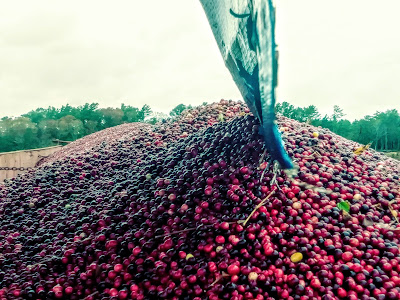 |
| As Thanksgiving draws near, we got down and dirty in the bogs so we could equip you with enough knowledge to dominate cranberry discussion. |
 |
| Cranberries grow in cooler Northern Hemisphere climates. The Southern Hemisphere also tries. 98% of the world's cranberries are grown the US, Canada and Chile. |
 |
| Wisconsin has supplanted long-time champ Massachusetts as the leading cranberry grower. |
 |
| However, I would point out that if your Thanksgiving cranberries aren't from Massachusetts, your table is wiggedy wiggedy whack. |
 |
| Bogs look like this, but have to be flooded to loosen the berries. More on that below... |
 |
| Bogs look cool with fog over them. |
 |
| The lack of ambient lighting sort of dulls the cranberry colors. When judging how bland this picture is, know that it was worse before we edited it. |
 |
| We were going to do a Fog Bog article, but Facebook spamming is high risk, so it's easier/safer to just have a Fog Bog section of a larger Cranberry article. |
 |
| 750 acres produces literal truckloads of cranberries. They are sent off to an Ocean Spray receiving plant in Carver. |
 |
| Revolutionary War vet Henry Hall of Dennis, Massachusetts started a bog in 1816, and he was shipping them commercially as far as Europe by the 1820s. |
 |
| 95% of cranberries are used to make either sauce or juice. Cranberry sauce is part of the traditional English Christmas dinner, as well as Christmas and Thanksgiving in the US of A. |
 |
| Once the bogs are flooded, a thresher like this one is used to loosen the berries. They are then fed to a truck after being raked up by those Ocean Spray commercial guys. |
 |
| Mann Farms of Buzzards Bay also let me roam around. |
 |
| Cranberry prices peaked at $65 a barrel in 1996, before plummeting to $18 a barrel in 2001. Production outpaced demand. |
 |
| Happy Thanksgiving! |












No comments:
Post a Comment